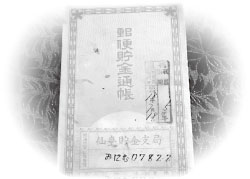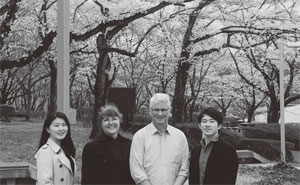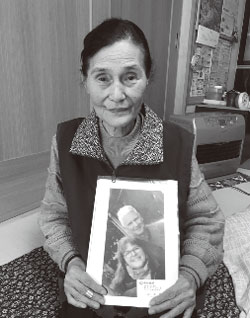Top>HAKUMON Chuo [2018 Summer Issue]>The Story of a Single Bankbook that Connected Japan and Denmark
Global Human Resources Development
The Story of a Single Bankbook that Connected Japan and Denmark
Chuo University Global Studies

Text and photographs by Koyo Yamamoto
Koyo Yamamoto graduated from the Faculty of Law, Chuo University in 2018. While enrolled at university, he belonged to the Chuo University Announce Society, where he served as Chairman.
After graduation, he entered employment at Diamond, Inc. Currently, he is a salesperson in charge of bookstores.

Bankbook found in the possession of a Danish married couple
In February of this year, my time at university was drawing to a close. Through the Global Studies Program held by the Faculty of Letters at Chuo University, I embarked on short-term study abroad at the University of Copenhagen in Denmark.
Denmark is located approximately 8,700 kilometers from Japan. A direct airline flight from Narita Airport takes 11 hours. My purpose of studying abroad was to learn about social security in Denmark, a country with an advanced welfare system.
During the daytime, I engaged in presentations and discussions with Danish students on the current state of social security in Denmark and Japan. It was a very fulfilling time for me.
Bankbook from 80 years ago

Sakura Plaza at Chuo University. From left: Rika Ishibashi (a friend of mine from a university seminar), Professor Marie Roesgaard, Professor Ingolf Roesgaard, and the author.
On my last day in Denmark, I stayed at the home of Professor Marie Roesgaard, an instructor of Japanese Studies at the University of Copenhagen.
Professor Roesgaard lived in Japan when she was a young child. Many of the items at her home were from Japan, from furniture and paintings to food and seasonings in her refrigerator.
For dinner, we ate roast pork, a traditional dish in Denmark. As I savored the delicious flavor, Professor Roesgaard’s husband Ingolf placed an old bankbook in front of my eyes.
When the Roesgaards visited Japan about four years ago, they stopped by an antique shop in Ginza, Tokyo. They purchased a chest of drawers and began using the chest at their home in Denmark.
One day about three years ago, they were using the chest as usual when they found a bankbook from the back of a drawer. Afterwards, the Roesgaards carefully stored the bankbook.
The bankbook lists the account holder as “Kenkichi Izawa.” It seems that the bankbook had been used from 1940 to 1943. Izawa had saved 50 sen every month as retirement savings.
Professor Ingolf, who taught history at the University of Copenhagen, said to me, “This is more than just an ordinary bankbook. It is a precious material which illustrates the lifestyle of Japanese people at that time. I would like you to search for the descendants of Kenkichi Izawa in Japan and give them this bankbook.”
Although I accepted Professor Ingolf’s request, the bankbook is from approximately 80 years ago when Japan was in the midst of war. The only clues that I had were the name “Kenkichi Izawa” and his past address.
However, I thought it was more than just mere coincidence that the bankbook had fell into the hands of a married couple with connections to Japan.
Ultimately, I felt a sense of purpose and vowed that I would find Izawa’s descendants.
Afterwards, while I was traveling through Europe, my mind was always fixed on the bankbook. I contacted some of my friends and professional acquaintances who are knowledgeable of postal savings and the Pacific War.
Even after returning to Japan, I had trouble finding any clues. However, after obtaining cooperation from countless people and patching together various hints, I was able to find the home telephone number of someone I suspected to be a descendant of Kenkichi Izawa.
Finding the answer in Yamagata

When I nervously dialed the telephone number, I heard the voice of an elderly woman on the other end. I explained what had happened, talking about the bankbook and my host family. I asked for permission to have a face-to-face discussion with the woman. Despite suddenly hearing such a suspicious story, she readily agreed.
The woman who answered my telephone call was Yoko Izawa (80 years old) in Yamagata Prefecture. She is the wife of one of Kenkichi Izawa’s grandsons. I immediately purchased the Shinkansen ticket heading to Yamagata Prefecture.
The next week, I headed to Yoko Izawa’s home in Yamagata. The trip from Tokyo Station took about three hours by the Shinkansen line. Yamagata was still chilly and lots of snow remained on the ground.
Even though we had spoken on the phone, I was still a complete stranger to Yoko. Nevertheless, she greeted me warmly. I immediately began asking about the chest of drawers and the bankbook.
Four years ago, Yoko had rebuilt her home together with her son and his family. At that time, they disposed of many items. A chest of drawers was included in the items that they had thrown away.
“I remember the chest of drawers very well,” said Yoko. “Without a doubt, the bankbook belonged to my ancestor Kenkichi Izawa. I had no idea that the bankbook was in the chest.”
While speaking, Yoko gazed nostalgically at a photograph of the chest which I had taken in Denmark.
Upon leaving, Yoko presented me with a handbag and money pouch which she had made from material taken from an old kimono.
“Please give the handbag to Mrs. Roesgaard,” she requested. “The money pouch is a gift for her husband.”
Bearing this goodwill from Yoko, I traveled back to Tokyo.

Mrs. Yoko Izawa
My graduation ceremony was held and the cherry blossoms reached full bloom at the end of March. The Roesgaards came from the University of Copenhagen to Japan. They visited Chuo University on their trip.
I told the Roesgaards that I had gone to Yamagata in order to meet with a descendant of Kenkichi Izawa, the holder of the bankbook. “I can’t believe that you actually found her!” said Professor Ingolf happily.
When I gave the Roesgaards the handbag and money pouch which Yoko had carefully made, the couple smiled at each other.
If a postal bankbook bearing the name “Kenkichi Izawa” had not been found in one of the drawers, we would never have known the whereabouts of the chest.
It seemed as if the bankbook itself was sending us a message: “The chest of drawers, which had been treasured for generations in Yamagata, is now in far-away Denmark in the loving care of a married couple with great affection for Japan.”
Perhaps this was a message from Kenkichi Izawa, who had diligently saved money in wartime Japan.
Ultimately, the bankbook crossed 80 years and 8,700 kilometers of time and space, connecting a Danish married couple and a Japanese family.
I strongly feel that this interaction was made possible by mutual feelings of goodwill. It taught me an important lesson—“goodwill will overcome national borders.”
Tell me more! Global Studies
The Global Studies Program is held by the Faculty of Letters at Chuo University. Students in other faculties can participate in this overseas studies program.
I participated in an overseas studies program led by Professor Fumi Karahashi held at the University of Copenhagen. Students went to Denmark in February after preparing through five classes held during the second semester.
Activities also went beyond classes. Acting on their own initiative, seminar students visited the Danish Embassy in Japan in order to speak with the Danish Ambassador to Japan.
Participating students can select their own research theme. In addition to improving their language skills, the program provides a unique opportunity for students to acquire expertise.
Tell me more! Background of this article
This was a wonderful story about a Danish married couple and a Japanese family living in Yamagata Prefecture. If I had never left Japan, I would never have learned of this story.
I wrote this article because I wanted to share my experience studying abroad with current Chuo students.
After graduating from university and starting a career, it is difficult to find a substantial length of time to travel outside Japan. I strongly recommend that students experience the outside world while they are enrolled at university.
- Research Activities as a Member of Research Fellowship for Young Scientists (DC1), Japan Society for the Promotion of Science (JSPS) Shuma Tsurumi
- Important Factors for Innovation in Payment Services Nobuhiko Sugiura
- Beyond the Concepts of Fellow Citizens and Foreigners— To Achieve SDGs Goal 10 “Reduce Inequality Within and Among Countries” Rika Lee
- Diary of Struggles in Cambodia Fumie Fukuoka
- How Can We Measure Learning Ability?
—Analysis of a Competency Self-Assessment Questionnaire— Yu Saito / Yoko Neha - The Making of the Movie Kirakira Megane

-
Newest Edition 2019 Autumn Issue
Student journalists report on the students’ take of Chuo University

-
Chuo-DNA
The school's history and motto have been passed on to graduates and students alike. Here is a visualization of Chuo University in the future.Core Energy
Launching Chuo University's Knowledge into Action to the rest of the world, like an infinity of sparkling stars scattered throughout space.
Planned by The Yomiuri Shimbun Business Bureau [PR]















